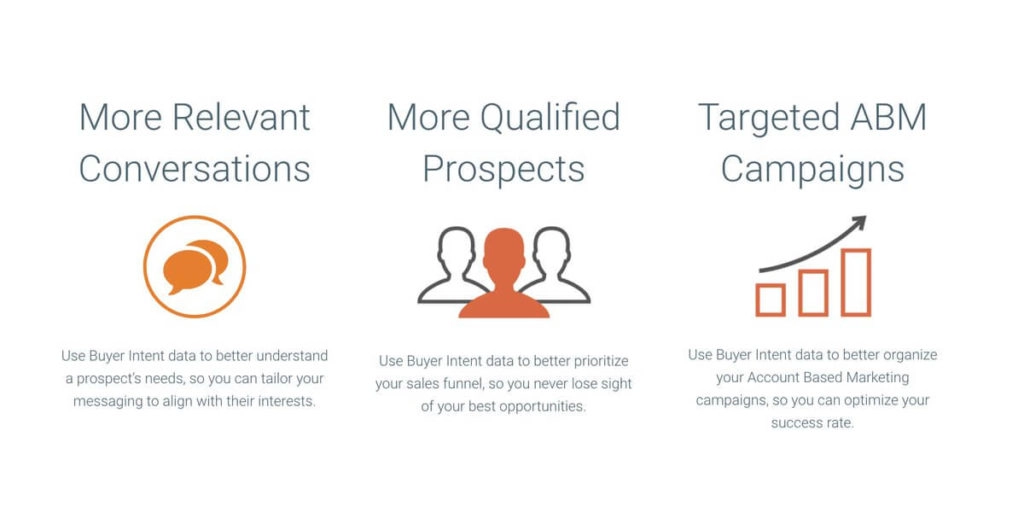
Introduction
“Intent data” are two words that hold the potential to revolutionize your sales and marketing workflow. Yet even though intent data has been a known concept for several years, b2b sales and marketers still seem unable to take advantage of it. B2b customers conduct their research online before buying and just like b2c customers, b2b customers also leave a digital footprint. However, b2c is more adept at using online behavioral data (intent data) to understand their customers and target them with better offerings.
Henry Schuck summarizes this rather well when he says, “the digital footprint that B2B buyers create may actually be bigger, or at least have more depth and breadth. So, why is it easier for a small floral delivery service to target a B2C buyer online than, say, a 1,000-person data security company that provides its services exclusively to financial services companies based in the United States?”
In this article, we will look at the relevance of intent data, particularly for sales and marketing professionals who practice account based marketing and want to scale up.
What is Intent Data?
Intent data is any topic -related activity that indicates a potential buyer’s interest in your business or industry. Such activities can take place on your website or third party sites and include:
- Website visits
- Downloads
- Product reviews
- Subscriptions to publications and other updates
- Webinar attendance
Metrics such as time spent on a specific web page, product reviews or consistent interest in a specific topic are also good indicators of the motivation behind a potential buyer’s activities. By monitoring such metrics, you get a better picture of what a buyer is really interested in.
Topic data falls under several categories:
First Party Behavioral Data
This refers to activities on your website. First party data can be further categorized as “known” or “anonymous”. Known activity data is collected from visitors who have provided personal information through contact forms. Anonymous data is activity carried out by visitors who are only identifiable by their company name (through their IP address).
Third Party Behavioral Data.
This refers to activities carried out on websites that are owned by other companies. Third party data can also be “known” or “anonymous”. Known third party intent data is activity collected from people who fill out forms on the third party sites they visit. Anonymous third party intent data refers to people who consume data from other sites without leaving their contact information.
Is Intent Data Enough on Its Own?
To take advantage of intent data, you must have access to other data types, such as context data and fit data.
Fit Data
Fit data tells you “WHO” is taking an action. Although topic data is important, it can only be actionable when you understand the visitor’s role. i.e, whether they are a good “fit” to pursue. Fit data can be high-level information, such as company name or role. Fit data can also contain granular insights such as an individual’s level of expertise with the product or technology they are researching.
Context Data
Context data tells you “WHY” a person is taking a specific action.
Different people within a company might research your product, but for different reasons. For instance, an analyst reading this article might be doing so purely for research purposes. On the other hand, if the reader is an account based marketing professional, they could be interested in understanding how to unlock the power of intent data to scale up their ABM program.

Advantages of Intent data
Often, the first salesperson to contact a buyer closes the customer. However, although monitoring intent indicators can ensure that a sales person is the first through the door, only 25% of b2b companies use intent data, according to a survey conducted by Demand Gen.
You may not know it, but it’s highly likely that you have a lot of prospects looking for a solution just like yours, to solve a problem they are struggling with. Such prospects spend their time online, consuming content, reading reviews and signing up for product trials, all to find options. This activity shows their “intent”. With intent data, you can identify and target your prospects’ pain points earlier in your stages of engagement.
How to Use Intent Data for ABM
Data allows you to be helpful to your customers.
Companies that do not harness intent data are “blind” and ineffective at responding to potential buyers. Below are several use cases for intent data in ABM.
Detecting buyer interest early in the sales cycle
Monitoring activities that denote purchase intent is useful because you will identify companies that are searching for yours or your competitors’ solution, way before they convert on your site.
Research shows that, most b2b buyers engage salespeople when they are already 67% through their buyer journey. The key to closing such prospects is to intercept them early in the sales cycle, so that they don’t end up buying from your competitor. With intent data, you can cut short your sales cycle and land more prospects.
Identify Upselling Opportunities
Retaining customers is a lot easier than recruiting new customers. With intent data, you can identify opportunities to upsell your database of existing customers and increase your level of engagement with them.
To provide a personalized experience for website visitors
There are technologies today that can help you identify who your visitors are. For instance, by tracking a visitor’s IP address, you can get information such as the company they work for. But as much as this is helpful, it doesn’t reveal any personal details about a visitor. For instance, are they a junior employee conducting their personal research or are they the CEO, CMO, CTO or CFO, researching with intent to buy?
By tracking the pages that your visitors view, you can customize content for them and in this way, encourage them to sign a form that will reveal more personal details that will be useful to your marketing and sales teams.
Score and prioritize leads
With marketing automation software, you can optimize your lead scoring using behavioral data. Some behavioral data is collected from activity carried out on your website. Using this data, you can score leads based on the pages they visit. For instance, a visitor who makes it all the way to your pricing page may score higher than one who only visits a product page.
Behavioral data collected from third party sites is also equally as useful. If leads visit other websites in your industry, you should start nurturing such leads before they visit your website.
Scoring leads shows you which accounts to prioritize. With intent data, you can give more weight to how you score leads and prioritize accounts with higher purchase interest before they close with a competitor.
Conduct Personalized Email Campaigns
When you use behavioral data to identify who your leads are and the influence or decision-making power they hold in their company, you can send them personalized emails with content that interests them.
B2b job titles can be misleading. For instance, just because two professionals hold the title “sales manager”, this doesn’t mean they have the same responsibilities, capability, level of seniority or decision power. Intent data helps you deal with this lack of standardization and better categorize your leads before conducting email campaigns.
Bottom Line
From everything we have discussed above, you can see the importance of intent data for targeted account based marketing. Collecting visitor activity from your website alone is not enough; you need data from other websites that deal with similar topics. To get third party data, you need to partner with the right data vendor, otherwise, you risk frustrating your marketing efforts.
Finding a vendor who will support your objectives and all use cases begins with asking the right questions. Ask the following:
Can you supply me with intent data from a wide context? E.g individual-level, topic, or company? The more context you have the better.
Can you provide me the raw data you have used in your modelling? This is important to compare against your scoring models.
What are some of the use cases for your offering? Settle for a vendor whose offering can apply to simple and sophisticated scenarios.
That said, you shouldn’t fail to start optimizing your ABM programmes if you don’t have 3rd party data. Get creative with the data you already have and improve as you go. And, as always, contact us for help if you have any challenges with the process.
Our blog
Latest blog posts
Tool and strategies modern teams need to help their companies grow.

B2B media buying has undergone a fundamental shift. What was once a straightforward, ...

It is for fact that today's buying environment demands more. With longer sales cycles...

To build a marketing strategy that drives real results, you need more than creative i...







